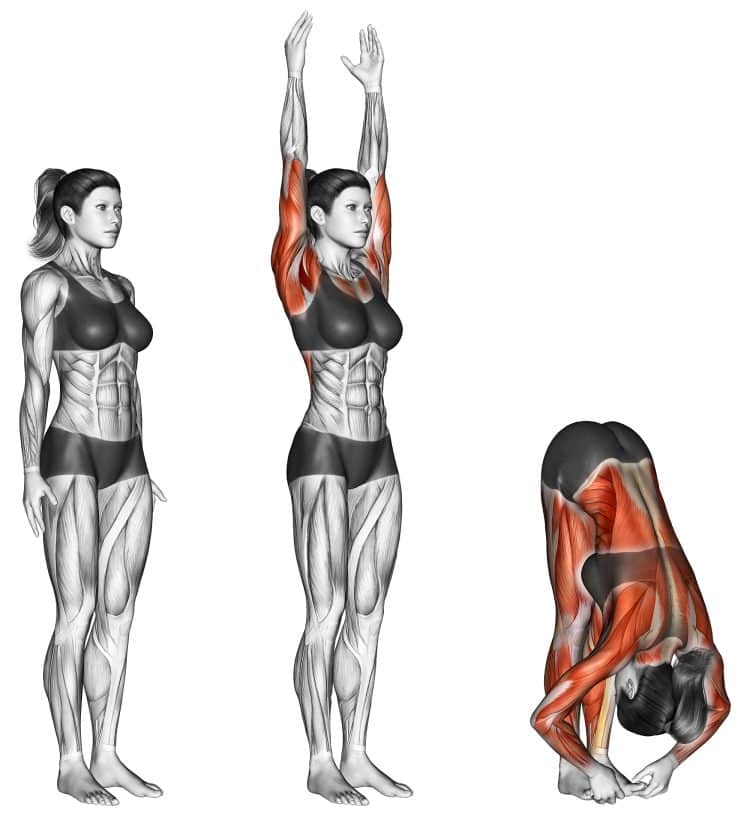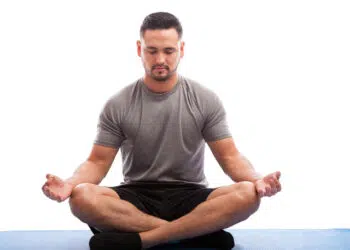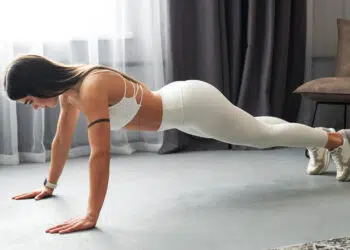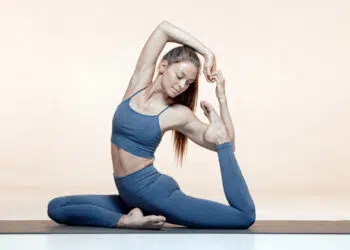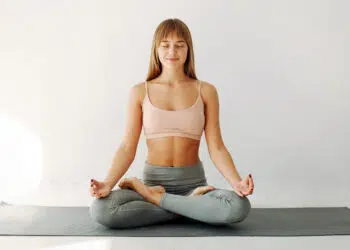“Can you touch your toes?”… an age old question and popular benchmark for assessing basic flexibility. Instantly exposing tight hamstrings, and poor mobility from the waist up, it can be a wakeup call for some! Hands to feet pose pada hastasana goes a little further than uttanasana, or the basic forward bend. The idea is to fold over far enough to slip the palms under the feet so the toes are touching wrists, before pulling the head as far into the legs as possible.
Demanding such a great degree of flexibility, you’ll almost look like a contortionist in the hands to feet pada hastasana pose.
But pada hastasana is more than just a taco pose; it should represent connecting energy from your upper and lower half, strengthening your foundation, fortifying your confidence, and teaching you full body control, and focus.
Let’s look at what hands to feet pose is, benefits, common mistakes, and variations.
Muscles Required During Pada Hastasana
Pada hastasana requires extreme flexibility which requires cooperation from several muscles, especially in the posterior chain. Here are short anatomy descriptions for the muscles engaged during this pose.
Level Up Your Fitness: Join our 💪 strong community in Fitness Volt Newsletter. Get daily inspiration, expert-backed workouts, nutrition tips, the latest in strength sports, and the support you need to reach your goals. Subscribe for free!
- Hamstrings – If it’s not very obvious, a fold over, toe touch stretch variation requires a very flexible set of hamstrings. These rear facing thigh muscles, opposite the quadriceps, pass through two joints to flex the knee, and extend the hip, like during leg curls, and standing up out of a squat, or jumping, respectively. Aligned by three heads, the hamstrings are very injury prone, and stretching them is a smart move.
- Erector spinae – The muscles that line the spine on either side, the erector spinae back muscles go to work during actions of bending over, standing up, and leaning laterally from the hips up.
- Abdominals – Pada hastasana also stimulates the abdominals, including both the exterior most and deeper fibers that assist with crunches, bending in various directions, and keeping the spine stiff for intense movements.
How To Do Hands To Feet Pada Hastasana
You don’t have to do any crazy bends or extreme balancing for the hands to feet pada hastasana. And you’ll find that the instructions are rather simple. But you do need great flexibility and experience controlling your body while performing various poses.
Follow the steps below, and watch the video demonstration as you perform this advanced forward bend variation.
Steps
- Start from standing with your feet a few inches apart from each other.
- Inhale, raise both arms overhead.
- Exhale, then slowly fold your upper body over until your head is upside down.
- When you can, slide your palms under your feet so that your toes are touching your wrists. Flex the front thigh muscles, or the quadriceps.
- If your flexibility allows, bend your body further toward your legs, bringing your head in between the legs, and focus your gaze between your lower legs.
- Stay here and focus on 5-8 deep breaths.
- Now slowly raise your head up, leaning your weight forward, and place your hands on the floor.
- Inhale, and come back to the original standing position while keeping the arms raised overhead.
- Exhale, then bring the arms down.
Pro tip: Bend the knees if you struggle to keep the legs fully straight.
Here’s a short video demonstration on pada hastasana.
Tips
- If you cannot fold fully into the pose, do not force it. Rather, hook your elbows behind your legs, grab your ankles, or even use straps to hold yourself in position.
- Again, bend your knees if you need to.
- Make sure to come out of the pose slowly, and consciously.
Benefits of Hands To Feet Pada Hastasana
You’re sure to get a plethora of benefits from this elite level forward bend over technique.
Powerful total body stretch
While the two main points are the hamstrings and wrists, hands to feet pose relieves the back muscles, loosens the neck, and moves tension from the head. Plus, one underrated positive side effect is stretching out the arms and shoulder muscles too.
Stretching tight muscles can help your posture long term due to better range of movement, increase your performance by promoting healthier muscle contractions, prevent muscle injuries, and open you up for other poses (1).
And while research isn’t totally conclusive, another potential advantage of stretching is reduced muscle soreness after training as stretching increased blood flow and circulation.
May enhance cognitive functioning
Like prasarita padottanasana, downward facing dog, and other similar upside down postures, pada hastasana also involves a form of inversion. While it’s not set in stone, there are beliefs that inversion techniques have benefits such as increased blood flow to the brain, a healthier spine, and injury prevention.
May promote stress relief
Yoga practice is believed to be an effective relaxation and stress relief activity, promoting mindfulness, focus, and muscle tension relief. It can be a form of meditation, and is great for becoming more in tune with yourself.
Level Up Your Fitness: Join our 💪 strong community in Fitness Volt Newsletter. Get daily inspiration, expert-backed workouts, nutrition tips, the latest in strength sports, and the support you need to reach your goals. Subscribe for free!
Common Mistakes
There are some things we should caution against when performing the hands to feet pose.
Forcing too hard
If you can’t get all the way down, don’t worry, you don’t have to. There are progression techniques such as a half forward bend, and 3/4 forward bend, and even consistent stretching will improve your flexibility over time. You don’t want to stress your tissues too quickly or you could injury yourself or cause long term damage.
While a little discomfort is normal during stretching, going from A to Z in one day is not the way to do it.
Check out the uttanasana forward bend under the variations section below to see demonstrations of the half and three quarters bend techniques.
Doing it right after eating
For obvious reasons, you should avoid performing hands to feet pose right after eating. Not just because it could really cause digestive discomfort, but this will severely distract from your ability to focus in the pose.
Variations of Hands To Feet Pada Hastasana
There are surprisingly many ways to perform a forward fold, and we’ve listed some of these variations below.
Standing forward bend uttanasana
The scaled back version of pada hastasana is the basic forward bend uttanasana. You still need an impressive level of flexibility to do it though. If not, you may need to start with the ardha uttanasana, or the standing partial forward bend, also shown in the video example below.
Here’s a helpful video explaining and demonstrating three uttanasana techniques.
Wide legged forward bend
Wide legged forward bend differs from pada hastasana in that the feet are, as the name says, spread wide apart. Consequently, the head can rest on the floor, plus, it also activates the adductors, which are the muscles that pull the leg inward. But make no mistake it’s not much easier. Both require a humbling level of flexibility!
Steps
- From standing, spread your feet wide, roughly 4-5 feet apart from each other. Find a balance between wide stance, and maintaining stability.
- Face your toes forward or slightly inward to activate the inner thighs and glutes, keep your legs straight and engaged, and shift your weight to your outer feet. Place your hands on your hips.
- Now fold forward at the hips, and lower your torso until your upper body is roughly parallel to the floor. Make sure to keep your back straight. Then, slowly stand up straight.
- Repeat step 4, but now stretch your arms down to the floor and touch it with your fingertips.
- Walk your hands back until your fingers and toes are in line, and press your palms flat on the floor.
- Lift your head up and gently stretch toward the sky.
- Then drop your head and body down toward the floor, while bending your elbows. Try to relax your upper body.
- Gently rest the crown of your head on the floor. Hold this position for a few seconds, trying not to exceed 10 seconds at first.
- Now come up onto your fingers, walk your hands forward, and bring your hands on your hips, one at time, then slowly stand up in the starting position.
Spread leg forward fold
Sitting, not standing, the spread leg forward fold offers a little more stability on the ground. But noting changes it’s still an intermediate level forward bend, so you can’t have a stiff back to do it.
Steps
- Sit on your mat, with your knees bent, feet on the floor, and arms resting on your legs.
- Now straighten your legs out in front of you, then spread them wide.
- Use your hands to gently adjust your glutes by pulling them out to ensure you’re able to maintain an upright posture and lengthened torso without restriction.
- Flex your feet by pulling the toes back toward your ankle, and press the heels into the ground.
- Then place your fingertips behind your butt on the floor, and pull the shoulder blades slightly toward each other, and down. Lift your chest up.
- Hold this position and feel the stretch throughout your body.
- If you’d like a more intense stretch, place your hands in front of you on the floor, then slowly walk your hands forward as much as you comfortably can.
- Now allow your upper body to sink down toward the floor to further the stretch. Remember to maintain a lengthened back, not simply hunching over.
- From here, if you do not have the flexibility to descend further, you can use a yoga bolster and/or stacked blankets for support.
- Gently lie your head down, facing either side, and rest your elbows on the floor with your palms facing up.
- Let your entire body relax and sink into the cushions, allowing your arms to also become heavy.
- Bring awareness to your groin, feeling the wide position of your legs, while allowing your lower body to sink down into the floor.
- Slowly breathe in and out.
- Stay here for about 5 minutes.
- To come out of the pose, turn your hands over onto your palms, then slowly sit up, walking your hands back toward you for support.
- Before you finish the pose, and if you’re comfortable, from the sitting position, place the bolster/blankets on one leg, and lie your head down to that one side for 3-5 minutes. Repeat on the other side.
Half moon pose
In bikram yoga, hands to feet pada hastasana follows the Half moon pose, as they tag team to give the spine an other-wordly stretch. Neither is easy for a beginner so you should be familiar with difficult poses before half moon.
Steps
- Come into a front forward leaning lunge with the right foot in front, toes pointed straight forward, and rear (left) foot pointing to the left.
- Now extend the left arm behind you and grab the back of the left leg/hip.
- Reach the right arm to the floor and lean onto your finger tips, with the hand directly under the shoulder.
- Rise up onto the front leg, and lift the rear leg up parallel to the floor. The lifted foot should be pointed to the left with the feet flexed by pulling the toes up toward the shin.
- Root down into the floor with the standing leg by pressing with the four corners of your feet, and extend the bottom leg.
- While looking down at the floor, extend the top arm vertical with the fingers pointing straight up toward the sky.
- Now you can adjust your gaze to the side or look up at the top hand to challenge your balance further.
- You’ll then perform the same technique but on the opposite leg.
Here’s a quick demo to get you on the right path to half moon pose!
FAQs
Who should not do hands to feet pada hastasana?
We do not recommend this inverted pose for those who suffer from high blood pressure, back issues such as sciatica, migraines, vertigo, or hyperextended knees.
Can you do pada hastasana right after eating?
Unlike some upright poses, like lotus, or hero, inverted postures are not recommend right after a meal, or even 30 minutes after. We suggest waiting a few hours after a meal to practice hands to feet, when you’re not full.
How long should I hold the hands to feet pose?
There’s no perfect number of duration to hold the pose. However, there are general recommendations based on experience level.
- Beginner: 2 sets x 10-15 seconds
- Intermediate: 2-3 sets x 20-30 seconds
- Advanced: 2-3 sets x 40-60 seconds
Wrapping Up
Hands to feet pada hastasana is your basic toe reach on steroids and it requires a very capable individual. Practicing basic daily yoga probably won’t be enough for this pose, so be prepared to spend more time on the mat first, in ardha uttanasana and uttanasana, then step up when you’re ready.
A head rush, this inverted posture could have unexpected benefits, although some said positives aren’t conclusive. So just do it because it feels good, and helps you to progress in your yoga journey!

